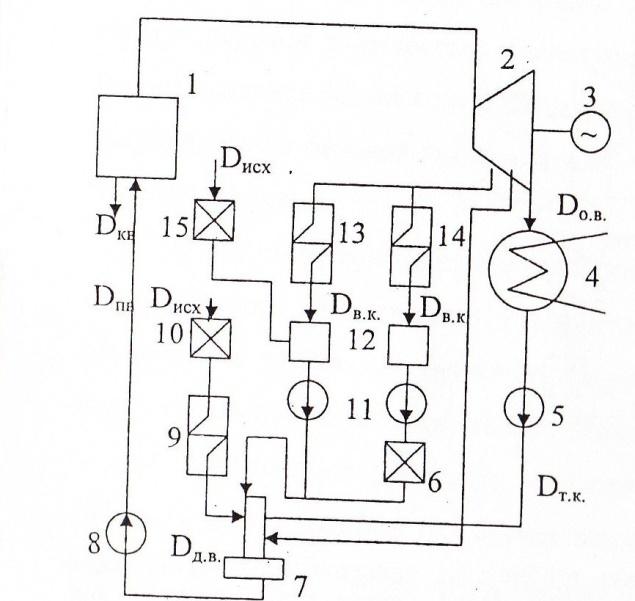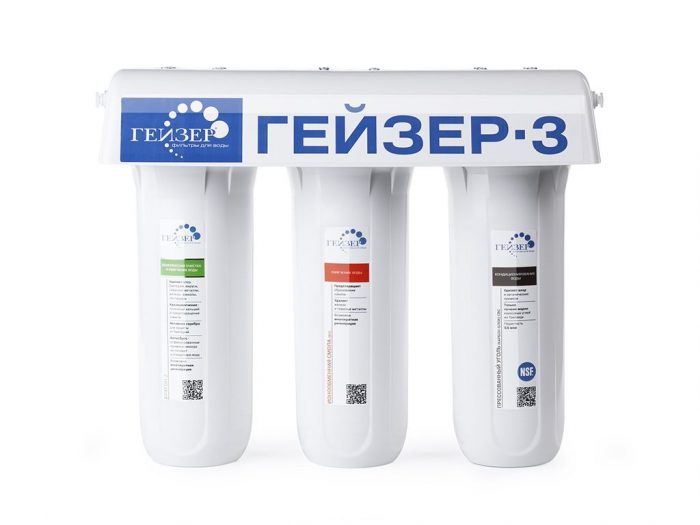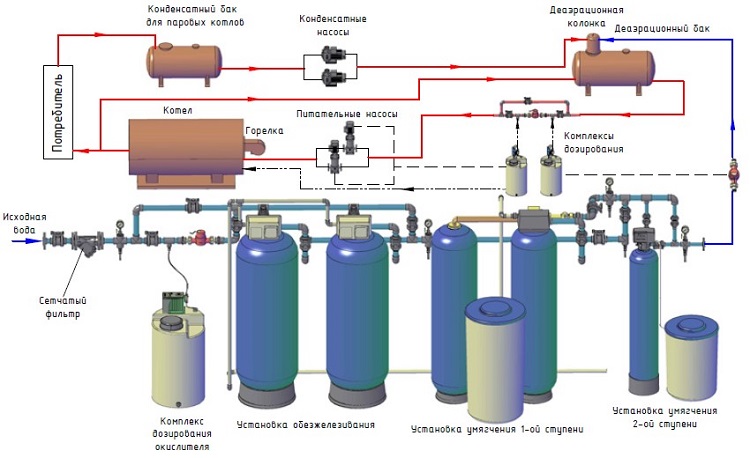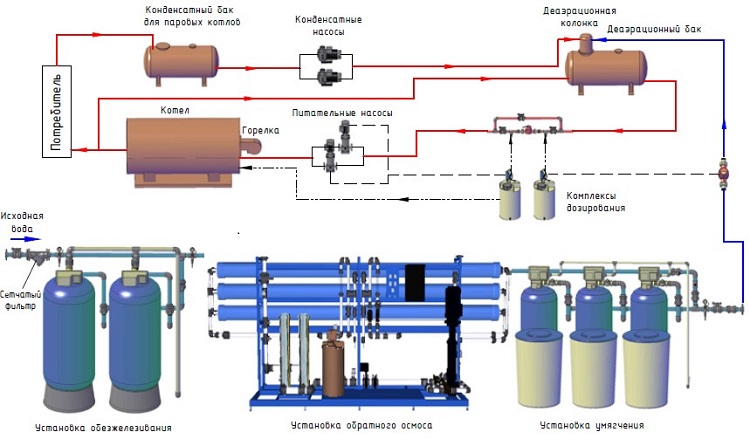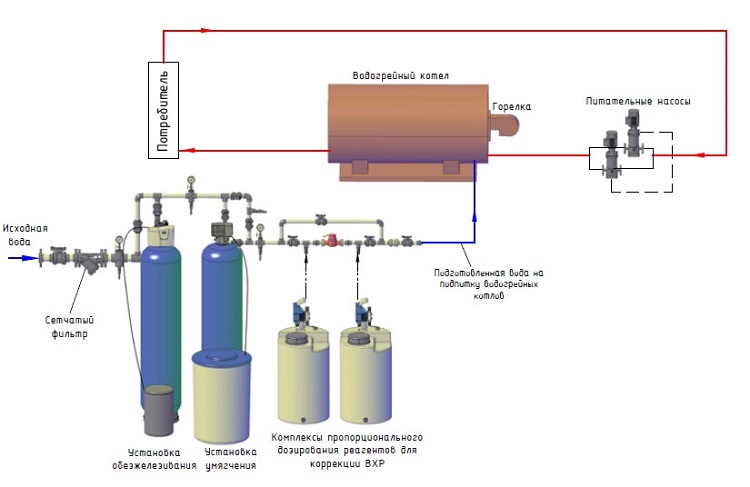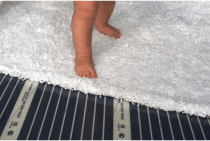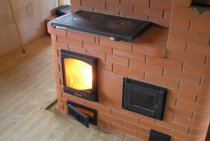Scale formation and feed water requirements
Together with the feed water, various mineral impurities enter the boiler. All impurities in water are divided into difficult and easily soluble. Salts and hydroxides of Ca and M^ are among the sparingly soluble impurities. The main scale formers have a negative temperature coefficient of solubility (i.e., as the temperature rises, their solubility decreases). Accumulating in the boiler as the water evaporates, these impurities, after the onset of the saturation state, begin to fall out of it. First of all, the state of saturation occurs for hardness salts Ca(HC03)2, Mg(HC03)2, CaCO2, M^C02 etc. The centers of crystallization are roughness on the heating surface, as well as suspended and colloidal particles in the boiler water. Substances that crystallize in the volume of water form particles suspended in it - sludge. Substances that crystallize on the heating surface form dense and durable deposits - scale. Scale, as a rule, has a low thermal conductivity of 0.1-0.2 W/(m-K). Therefore, even a small layer of scale leads to a sharp deterioration in the cooling conditions of the metal of the heating surfaces and, as a result, to an increase in its temperature, which can lead to a loss of strength of the pipe wall and its destruction. In addition, scale leads to a significant reduction in the efficiency of the boiler as a result of a decrease in the heat transfer coefficient and the associated increase in flue gas temperature.
The concentration of sodium salts in the evaporative surface water is always below their saturation limit. However, these salts can also be deposited on the heating surfaces in those cases when the water droplets that are in the steam and fall on the heating surfaces evaporate completely, which takes place in superheaters.
Compounds of iron, aluminum and copper, which are in water in the form of dissolved colloidal and ultrafine suspensions, can also be deposited on heating surfaces and be part of the scale. Scales from iron and copper oxides are formed in areas of high local thermal loads of heating surfaces, most often in screen pipes.
In high-pressure boilers at pressures over 7 MPa, silicic acid H25Yu3 acquires the ability to dissolve in steam, and with increasing pressure, this ability increases significantly. Entering the superheater together with steam, silicic acid decomposes with the release of H20. As a result, 8U appears in the pair2, which, getting on the blades of steam turbines, forms insoluble compounds on them, which worsen the efficiency and reliability of the turbine.
A negative effect on the operation of heating surfaces is the content of mineral oils and heavy petroleum products in the feed water, which can come with condensate from industrial consumers. The deposition of a low thermally conductive film of oil or oil products worsens the cooling conditions of the heating surfaces and has the same effect as scale.
The operation of the boiler is adversely affected by the increased alkalinity of the water, which leads to foaming of the water in the drum. Foaming of water is facilitated by the content of organic compounds and ammonia in it. Under these conditions, separation devices do not ensure the separation of water droplets from steam, and water from the drum containing various impurities can enter the superheater, creating a risk of contamination. In addition, increased alkalinity can cause alkaline corrosion of the metal, as well as cracks in the places where pipes are rolled into collectors and the drum.
Aggressive gases dissolved in feed water 02, С02 cause various forms of corrosion of the metal, leading to a decrease in its mechanical strength.The reduced alkalinity of the water accelerates corrosion, and a certain level must be maintained in the feed water. In low-pressure boilers, the required pH level is maintained by introducing soda into the feed water, and in high-pressure boilers, phosphates or ammonia.
Based on the foregoing, the maximum permissible content of harmful impurities in feed water is standardized.
Water circulation in the operating cycle of a thermal power plant
Water
and water vapor are heat carriers
in the water and water steam paths of thermal power plants, thermal power plants
and nuclear power plants.
At
solution of the water problem TPP large
what matters is that the transition to high
and supercritical pressure significantly
changes the conditions of vaporization,
heat transfer during boiling, hydrodynamics
steam mixture in the boiler pipes, as well as
properties of the working body itself.
TO
For example, with an increase in pressure sharply
water vapor density increases
the speed of the steam-water mixture decreases
in steam pipes, decreases
surface tension and viscosity
water, which contributes to the formation
scale and corrosion.
WITH
an increase in the density of water vapor
increases its ability to
dissolution of various chemical
compounds contained in the boiler
water, resulting in significant
removal of inorganic substances present in the water
impurities.
Water
TPP applies:
-
for
steam production in boilers, evaporators; -
for
exhaust steam condensation
steam turbine condensers and
other heat exchangers; -
for
cooling of blowdown water and bearings
smoke exhausters; -
v
as a working coolant
cogeneration heating networks
and hot water networks.
Water
steam obtained in boilers, and then
spent in turbines is subjected to
condensation or in the form of reduced steam
parameters used on
industrial and municipal
enterprises for technological
processes, heating and ventilation.
Rice.
1.1. IES scheme:
1
- steam boiler; 2
- steam turbine; 3
- electric generator; 4
- water treatment plant; 5
- capacitor; 6
— condensate pump; 7
— condensate treatment (BOU); 8
- HDPE; 9
- deaerator; 10
- feed pump; 11
- PVD.
DISH.V.—
source water.
DD.V.
- additional water is sent to the circuit
to replenish steam and condensate losses
after processing with
physical and chemical cleaning methods.
dT.K.
—
turbine condensate, contains a small
the amount of dissolved and suspended
impurities - the main component
feed water.
DVC.
— return condensate from external
steam consumers, used after
cleaning in reverse cleaning plant
condensate (7)
from
introduced contaminants. Is a composite
part of the feed water.
Dp.c.
- feed water, supplied to the boilers,
steam generators
or
reactors
to replace evaporated water in these
units. Is a mixture
DT.K,
DD.V.,
DVC.
and condenses in the elements of the indicated
aggregates.
Rice.
1.2. TPP scheme:
1
- steam boiler; 2
- steam turbine; 3
— electric generator;
4
- capacitor; 5
— condensate pump; 6
– installation for cleaning the return
condensate; 7
- deaerator; 8
- feed pump; 9
— additional water heater; 10
— water treatment for feeding boilers; 11
— reverse condensate pumps; 12
— return condensate tanks; 13
— industrial consumer of steam;
14
— industrial consumer of steam; 15
— water treatment for feeding the heating system.
DETC
- blowdown water - is discharged from the boiler,
steam generator or reactor for cleaning
or into the drain to maintain in the evaporated
(boiler) water of given concentrations
impurities. Composition and concentration
impurities in boiler and blowdown water
are the same.
DO.V.
—
cooling or circulation water,
used in steam condensers
turbines for condensing spent
pair.
DV.P.
- make-up water of the heating network, for
make up for losses.
Methods and ways of water preparation
Many negative factors are eliminated by preliminary heat treatment and filtration. In other cases, the preparation of water for the heating system includes several stages of cleaning with additives, reagents to give the coolant the desired characteristics.
Methods that can be used before filling the heating system:
- Addition of reagents. These are certain chemicals that reduce the excess content of certain components that adversely affect the system.
- catalytic oxidation. Required with a high content of iron impurities. The oxidative process binds impurities and removes them as a precipitate.
- Filtration. Various mechanical filters are installed for the process. The filling of the units depends on the chemical composition of the water.
- Softening through the application of electromagnetic waves.
- Freezing, boiling or settling water for a certain time period. It turns out distilled water for heating, which is considered the best heat carrier.
- deaeration process. This is necessary with an excess of oxygen, carbon dioxide and other gases.
Stages of water treatment of the boiler house
The cleaning steps for the boiler room can be divided into the following types:
- Mandatory steps:
- Rough mechanical cleaning.
- Softening and desalting with ion-exchange resins, reverse osmosis.
- Additional steps - used when the content of iron, manganese is increased:
- Aeration.
- Iron removal.
The stages of water treatment for a boiler room differ depending on the type of boiler. Let's give some examples.
Treatment of water for steam boilers by the method of two-stage Na-cationization with preliminary iron removal:
Water treatment for steam boilers by reverse osmosis:
Water treatment for hot water boilers with a capacity of more than 1 m3 / h:
mechanical filter
This is a coarse filter, its task is not only to clean large particles, but also to protect the rest of the system - subsequent filters from suspended matter. A mechanical filter is the first line of protection for a water treatment system, which prevents coarse sand, stones, and scale from entering the system.
Iron removal column
The aeration station and the iron removal column work in conjunction. For iron removal, special catalytic loadings are used. Backfill oxidizes the dissolved iron and passes the filtered water on.
aeration station
If the water contains a high content of elements such as iron, manganese, then an aeration station is needed - a column and a compressor. The principle of aeration is the supply of oxygen, which causes the process of oxidation of pollutants.
Ion exchange filter or reverse osmosis
The last stage is softening and desalination of water. Depending on the degree of purification required, an ion exchange filter or reverse osmosis is used.
The use of ion exchange resin will be cheaper. If at this stage only softening is needed, then the ionic column will cope with the task.
If the water is high in salt content, then a reverse osmosis system is used. It removes 99% of mineral salts and pollutants from water. The main disadvantage is the high cost of equipment and high water consumption - about half is discharged into the drain during filtration.
Each stage of boiler water treatment is important for cleaning and protecting boilers from the formation of mineral deposits that lead to breakdowns.
To avoid such problems and unnecessary expenses, it is recommended that the correct maintenance of the water treatment system be carried out.
Water treatment for the boiler room. Boiler water. Installation and maintenance of boiler installations.
Water in thermal power engineering.Terms and Definitions.
The water used for steam and hot water boilers, depending on the technological area, has different names fixed in regulatory documents:
Raw water is water from a water source that has not been purified and chemically treated.
Feed water - water at the inlet to the boiler, which must comply with the parameters specified by the project (chemical composition, temperature, pressure).
Make-up water is water intended to make up for losses associated with boiler blowdown and leakage of water and steam in the steam condensate path.
Make-up water is water intended to make up for losses associated with boiler blowdown and water leakage in heat-consuming installations and heating networks. Boiler water is the water circulating inside the boiler.
Direct network water - water in the pressure pipeline of the heating network from the source to the heat consumer.
Return network water - water in the heating network from the consumer to the network pump.
Boiler classification. Terms and Definitions.
According to the method of obtaining energy for heating water or generating steam, boilers are divided into: - Energy technology - boilers, in the furnaces of which the processing of technological materials (fuel) is carried out; - Waste heat boilers - boilers that use the heat of hot waste gases from the process or engines; - Electric - boilers that use electrical energy to heat water or produce steam.
According to the type of circulation of the working medium, boilers are divided into boilers with natural and forced circulation. Depending on the number of circulations, boilers can be direct-flow - with a single movement of the working medium, and combined - with multiple circulation.
Regarding the movement of the working medium to the heating surface, there are: - Gas-tube boilers, in which the combustion products of fuel move inside the pipes of the heating surfaces, and water and steam-water mixture - outside the pipes. - Water tube boilers, in which water or a steam-water mixture moves inside the pipes, and the products of fuel combustion - outside the pipes.
In addition to the regulatory documentation, it is necessary to take into account the recommendations of the boiler manufacturer, specified in the operating instructions / user manual.
DHW network water must comply with the standards "SanPiN 2.1.4.1074-01. Drinking water. Hygienic requirements for water quality of centralized drinking water supply systems. Quality control".
raw water impurities. Methods of water treatment for the boiler room.
For water from a well, the excess content of iron and manganese is characteristic, which also affect the operating mode of boiler equipment. The choice of deironing method is determined by many factors - from the productivity of the installation to associated impurities.
There are a large number of reagents designed to inhibit the processes of scaling and corrosion. Traditionally, automatic dosing stations are used to introduce a reagent into pretreated water. In some cases, the reagents are compatible and can be dosed from one container of working solutions, in others, several dosing stations are required. When using chemical corrective treatment, it is necessary to monitor the preparation of dosing solutions and constantly monitor the concentrations of dosed substances in the boiler water.
The AquaGroup company guarantees an individual approach to the selection and calculation of the water treatment plant for each facility.

